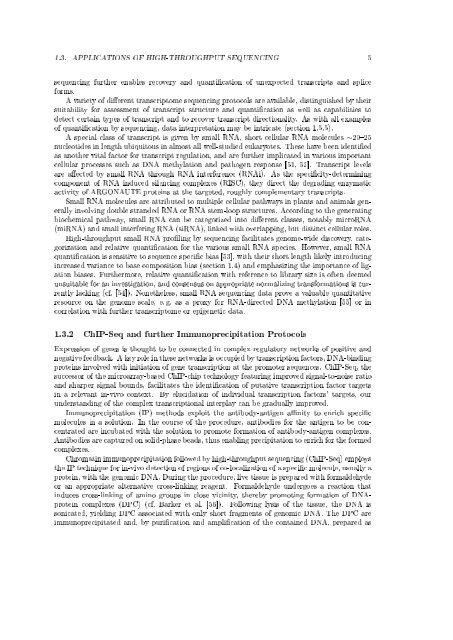An Integrated Data Analysis Suite and Programming ... - TOBIAS-lib
An Integrated Data Analysis Suite and Programming ... - TOBIAS-lib
An Integrated Data Analysis Suite and Programming ... - TOBIAS-lib
You also want an ePaper? Increase the reach of your titles
YUMPU automatically turns print PDFs into web optimized ePapers that Google loves.
1.3. APPLICATIONS OF HIGH-THROUGHPUT SEQUENCING 5<br />
sequencing further enables recovery <strong>and</strong> quantication of unexpected transcripts <strong>and</strong> splice<br />
forms.<br />
A variety of dierent transcriptome sequencing protocols are available, distinguished by their<br />
suitability for assessment of transcript structure <strong>and</strong> quantication as well as capabilities to<br />
detect certain types of transcript <strong>and</strong> to recover transcript directionality. As with all examples<br />
of quantication by sequencing, data interpretation may be intricate (section 1.5.5).<br />
A special class of transcript is given by small RNA, short cellular RNA molecules ∼2025<br />
nucleotides in length ubiquitous in almost all well-studied eukaryotes. These have been identied<br />
as another vital factor for transcript regulation, <strong>and</strong> are further implicated in various important<br />
cellular processes such as DNA methylation <strong>and</strong> pathogen response [51, 52]. Transcript levels<br />
are aected by small RNA through RNA interference (RNAi). As the specicity-determining<br />
component of RNA induced silencing complexes (RISC), they direct the degrading enzymatic<br />
activity of ARGONAUTE proteins at the targeted, roughly complementary transcripts.<br />
Small RNA molecules are attributed to multiple cellular pathways in plants <strong>and</strong> animals generally<br />
involving double str<strong>and</strong>ed RNA or RNA stem-loop structures. According to the generating<br />
biochemical pathway, small RNA can be categorized into dierent classes, notably microRNA<br />
(miRNA) <strong>and</strong> small interfering RNA (siRNA), linked with overlapping, but distinct cellular roles.<br />
High-throughput small RNA proling by sequencing facilitates genome-wide discovery, categorization<br />
<strong>and</strong> relative quantication for the various small RNA species. However, small RNA<br />
quantication is sensitive to sequence specic bias [53], with their short length likely introducing<br />
increased variance to base composition bias (section 1.4) <strong>and</strong> emphasizing the importance of ligation<br />
biases. Furthermore, relative quantication with reference to <strong>lib</strong>rary size is often deemed<br />
unsuitable for an investigation, <strong>and</strong> consensus on appropriate normalizing transformations is currently<br />
lacking (cf. [54]). Nonetheless, small RNA sequencing data prove a valuable quantitative<br />
resource on the genome scale, e. g. as a proxy for RNA-directed DNA methylation [55] or in<br />
correlation with further transcriptome or epigenetic data.<br />
1.3.2 ChIP-Seq <strong>and</strong> further Immunoprecipitation Protocols<br />
Expression of genes is thought to be connected in complex regulatory networks of positive <strong>and</strong><br />
negative feedback. A key role in these networks is occupied by transcription factors, DNA-binding<br />
proteins involved with initiation of gene transcription at the promoter sequences. ChIP-Seq, the<br />
successor of the microarray-based ChIP-chip technology featuring improved signal-to-noise ratio<br />
<strong>and</strong> sharper signal bounds, facilitates the identication of putative transcription factor targets<br />
in a relevant in-vivo context. By elucidation of individual transcription factors' targets, our<br />
underst<strong>and</strong>ing of the complex transcriptional interplay can be gradually improved.<br />
Immunoprecipitation (IP) methods exploit the antibody-antigen anity to enrich specic<br />
molecules in a solution. In the course of the procedure, antibodies for the antigen to be concentrated<br />
are incubated with the solution to promote formation of antibody-antigen complexes.<br />
<strong>An</strong>tibodies are captured on solid-phase beads, thus enabling precipitation to enrich for the formed<br />
complexes.<br />
Chromatin immunoprecipitation followed by high-throughput sequencing (ChIP-Seq) employs<br />
the IP technique for in-vivo detection of regions of co-localization of a specic molecule, usually a<br />
protein, with the genomic DNA. During the procedure, live tissue is prepared with formaldehyde<br />
or an appropriate alternative cross-linking reagent. Formaldehyde undergoes a reaction that<br />
induces cross-linking of amino groups in close vicinity, thereby promoting formation of DNAprotein<br />
complexes (DPC) (cf. Barker et al. [56]). Following lysis of the tissue, the DNA is<br />
sonicated, yielding DPC associated with only short fragments of genomic DNA. The DPC are<br />
immunoprecipitated <strong>and</strong>, by purication <strong>and</strong> amplication of the contained DNA, prepared as
















